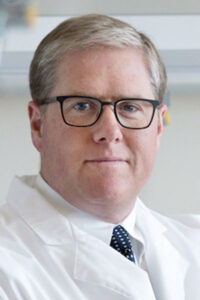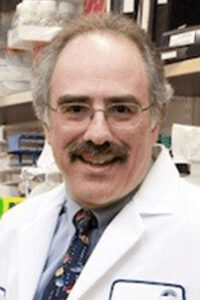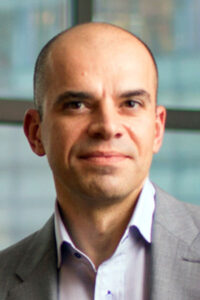Clarkson Symposium explores stem cells, leukemia, and the niche
//
Estimated Read Time:

Bayard D. Clarkson, MD, is considered an icon in cancer research. His work was celebrated during the symposium AACR-Bayard D. Clarkson Symposium on Stem Cells, Leukemia, and the Niche during the American Association for Cancer Research Annual Meeting 2021.
“His study of cell cycle distribution in human leukemia cells in vivo in actual human patients should be required reading for today’s leukemia biologist,” said session moderator Sean J. Morrison, PhD, Children’s Medical Center Research Institute at UT Southwestern.
The symposium is part of this year’s On Demand sessions, and a companion live panel discussion with the presenters will take place Monday, April 12, from 10 – 10:30 a.m. EDT. When viewing the On Demand session, viewers can submit their questions in a provided Q&A box. All questions submitted before the live session will reach the panelists.
Distinct niches
Morrison discussed his lab’s work to characterize the niche for hematopoietic stem cells (HSC) and progenitors in the bone marrow.
“We discovered that HSC reside adjacent to sinusoidal blood vessels on blood vessels in the spleen in adult mice and are sustained by growth factors synthesized by LepR+ stromal and endothelial cells,” Morrison said. “We discovered the LapR+ cells turned out to be a major source of many critical growth factors in the bone marrow, particularly growth factors required for maintenance of HSC.”
A later experiment looked for transcripts in LapR+ cells that were predicted to encode secreted proteins that looked like growth factors. Osteolectin, a new bone-forming growth factor, was discovered. Osteolectin promotes the differentiation of lepR+ cells into osteoblasts and can be used as a marker.
In a mouse model, osteolectin-positive cells represented only 0.025% of bone marrow cells. All of the osteolectin positive cells were LepR+, but only a subset of LepR+ cells expressed osteolectin. Additionally, within the bone marrow, osteolectin is expressed by peri-arteriolar LepR+ cells but not peri-sinusoidal cells.
“This was exciting because we had shown years ago that LepR+ cells around sinusoids are maintaining HSCs and at least certain early restrictive progenitors but realized there were LepR+ cells around the arterials but we did not know what they did,” Morrison said.
Gene-expressing profiling showed peri-arteriolar LepR+ cells are poised to undergo osteogenesis while peri-sinusoidal LepR+ cells are poised to undergo adipogenesis. This made osteolectin the first validated marker to integrate function of peri-arteriolar cells.
Further studies into osteolectin raised the possibility that osteolectin positive peri-arteriolar cells are creating a niche for early lymphoid progenitors within the bone marrow. These peri-arteriolar niches promote lymphopoiesis and bacterial clearance after acute infection.
Endothelial cuddling

Leonard I. Zon, MD, Harvard Medical School, detailed multiple experiments in zebrafish that provided insight into hematopoietic stem and progenitor cells and their niche.
In one study, they found that a small group of endothelial cells remodel around a single hematopoietic stem and progenitor cell to form a pocket, which they called “endothelial cuddling.”
“Looking at the niche, what we saw were five endothelial cells that surround the stem cell in a pocket perhaps providing a protective environment for the stem cell or a local concentration of growth factor that would stimulate it,” Zon said. “The stem cell is physically bound to a stromal cell on which it will divide.”
That niche was very interesting, and it was studied more using RNA tomography that allowed them to see niche-specific genes, including 29 genes selectively enriched in caudal hematopoietic tissue niche endothelial cells.
Further experiments showed that they were able to find a code for how to make niche endothelial cells and what was necessary to reprogram these endothelial cells.
In the latter half of his presentation, Zon discussed the influences of macrophages and the niche on clonality.
Microenvironment

Iannis Aifantis, PhD, NYU Grossman School of Medicine, discussed the evolving immune microenvironment of acute lymphoblastic leukemia (ALL).
The concept of the leukemia microenvironment is something particularly new, Aifantis said, but it is known that several components of the microenvironment are important for the progression of hematologic malignancies. Aifantis and others have published and discussed the role of stromal or immune microenvironment in this transformation process.
Aifantis’ presentation focused the immune microenvironment and myeloid cells for progression of ALL. He discussed a study designed to map the B-ALL immune microenvironment not only at diagnosis but in response to conventional chemotherapy. Aifantis and colleagues found extensive remodeling of the immune bone marrow microenvironment, including an increase in B cells and a large decrease in myeloid cells, macrophages, and monocytes.
To explore this further, they also looked at the microenvironment during treatment. For example, in patients with aggressive, Philadelphia chromosome-positive B-ALL there was an over-abundance of CD19 positive cells at baseline. After chemotherapy, these cells went into remission, with about 1 percent left. After relapse, the B-ALL cells were back with a vengeance, Aifantis said.
Specifically, Aifantis discussed the changes in myeloid cells and their clusters, as well as the role of monocytes. He detailed studies that show that high monocyte abundance in bone marrow and blood predicted inferior overall B-ALL patient survival in both a pediatric and adult cohort. He also discussed whether it might be possible to target leukemia-associated monocytes to enhance B-ALL therapy, and how monocyte depletion enhances TKI sensitivity in vivo.


